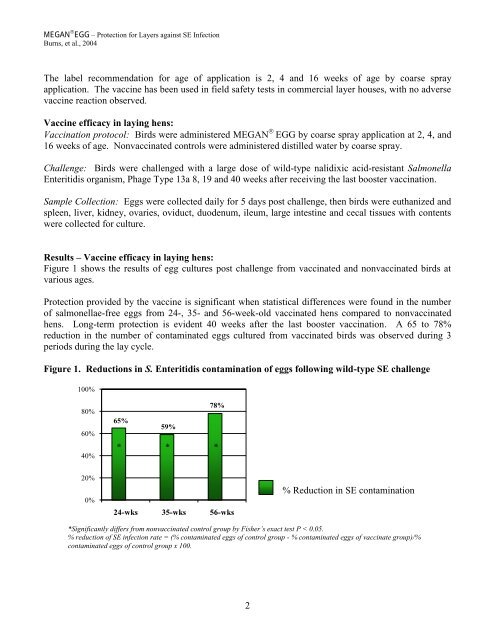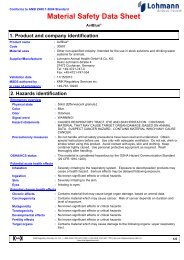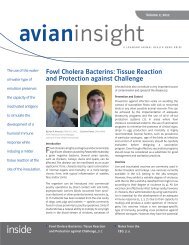Megan Article - Lohmann Animal Health
Megan Article - Lohmann Animal Health
Megan Article - Lohmann Animal Health
Create successful ePaper yourself
Turn your PDF publications into a flip-book with our unique Google optimized e-Paper software.
MEGAN EGG – Protection for Layers against SE Infection<br />
Burns, et al., 2004<br />
The label recommendation for age of application is 2, 4 and 16 weeks of age by coarse spray<br />
application. The vaccine has been used in field safety tests in commercial layer houses, with no adverse<br />
vaccine reaction observed.<br />
Vaccine efficacy in laying hens:<br />
Vaccination protocol: Birds were administered MEGAN EGG by coarse spray application at 2, 4, and<br />
16 weeks of age. Nonvaccinated controls were administered distilled water by coarse spray.<br />
Challenge: Birds were challenged with a large dose of wild-type nalidixic acid-resistant Salmonella<br />
Enteritidis organism, Phage Type 13a 8, 19 and 40 weeks after receiving the last booster vaccination.<br />
Sample Collection: Eggs were collected daily for 5 days post challenge, then birds were euthanized and<br />
spleen, liver, kidney, ovaries, oviduct, duodenum, ileum, large intestine and cecal tissues with contents<br />
were collected for culture.<br />
Results – Vaccine efficacy in laying hens:<br />
Figure 1 shows the results of egg cultures post challenge from vaccinated and nonvaccinated birds at<br />
various ages.<br />
Protection provided by the vaccine is significant when statistical differences were found in the number<br />
of salmonellae-free eggs from 24-, 35- and 56-week-old vaccinated hens compared to nonvaccinated<br />
hens. Long-term protection is evident 40 weeks after the last booster vaccination. A 65 to 78%<br />
reduction in the number of contaminated eggs cultured from vaccinated birds was observed during 3<br />
periods during the lay cycle.<br />
Figure 1. Reductions in S. Enteritidis contamination of eggs following wild-type SE challenge<br />
100%<br />
80%<br />
60%<br />
40%<br />
78%<br />
65%<br />
59%<br />
* * *<br />
20%<br />
0%<br />
24-wks 35-wks 56-wks<br />
% Reduction in SE contamination<br />
*Significantly differs from nonvaccinated control group by Fisher’s exact test P < 0.05.<br />
% reduction of SE infection rate = (% contaminated eggs of control group - % contaminated eggs of vaccinate group)/%<br />
contaminated eggs of control group x 100.<br />
2
















